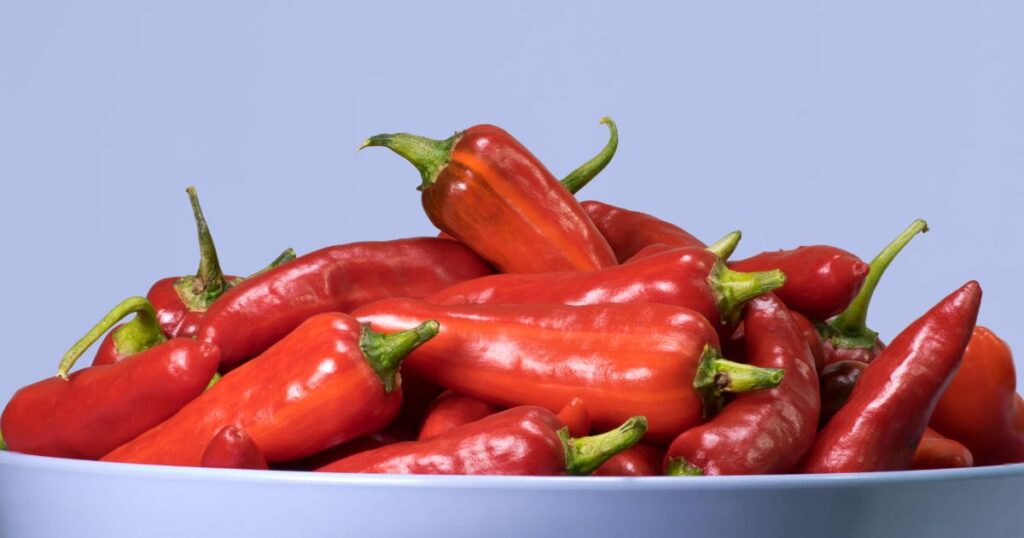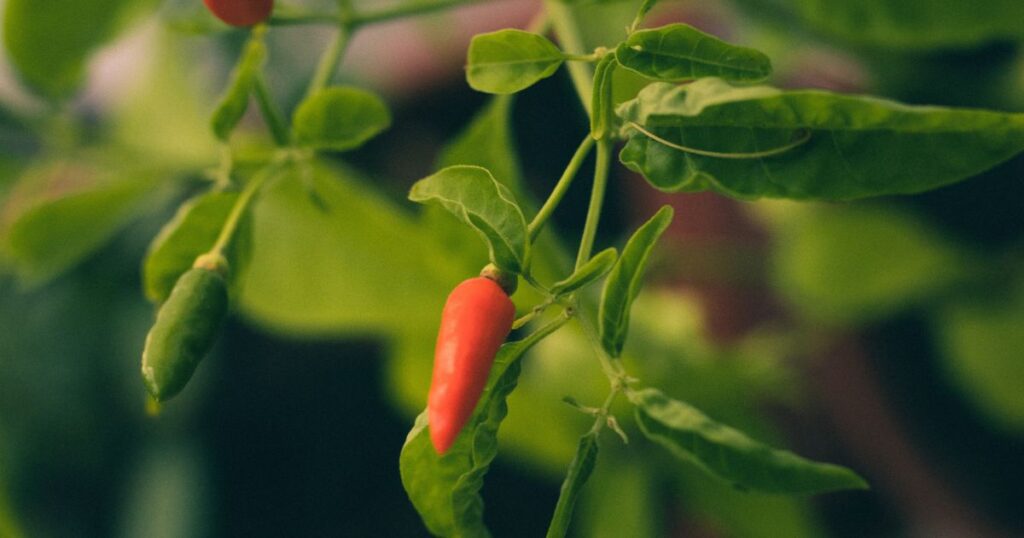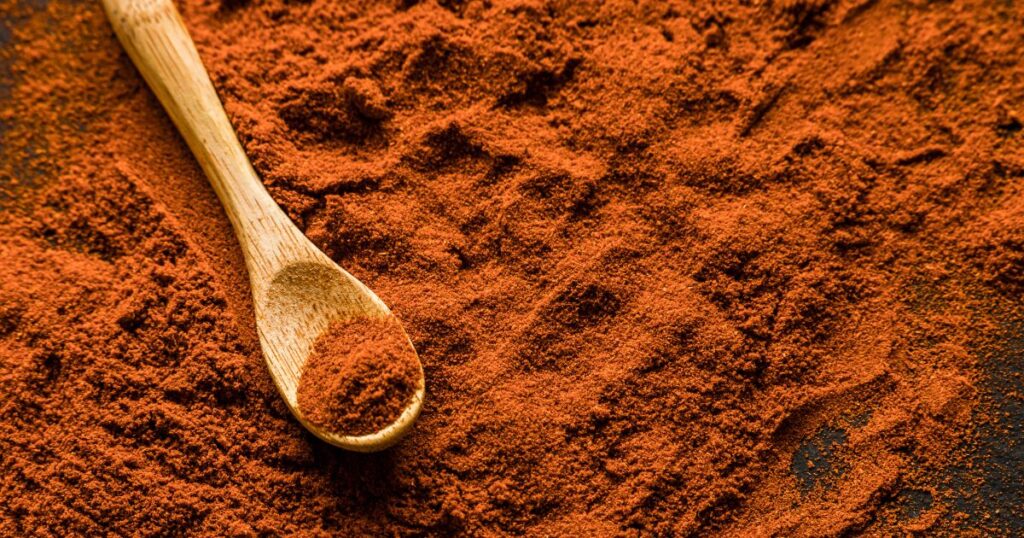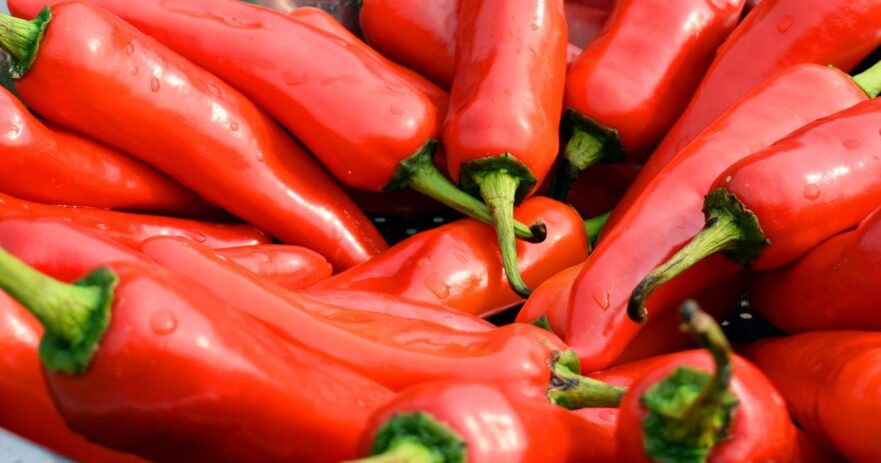In this article about fish pepper:
🗺️ Origin and history | 🌶️ Uses | ✨ Appearance and taste | 🧑🌾 Growing – gardening | 👨🍳 Cooking – recipes | 🛒 Where to buy | 🫙 How to store | 👨⚕️ Health benefits | 🌶️ Alternatives and substitutes | ❓ Frequently asked questions
What is a fish pepper?
Fish peppers are unique chili pepper with a rich heritage and distinctive appearance. This pepper holds an exciting place in culinary history. It is often used in African American and Caribbean cuisine. Renowned for their striking variegated leaves and peppers, fish peppers are as decorative as they are delicious, adding color to any garden or dish.
Characterized by changing hues, fish peppers transform from pale yellow or white with green stripes to orange with brown stripes and eventually to solid red as they mature. This vibrant progression makes them an attractive addition to various dishes. Their heat level fluctuates, ranging from mild when white to moderate when red.
Fish peppers often add a subtle zing and vibrant color to seafood dishes, hence their name. They can be used fresh or dried and ground. Given their flavor and color, these peppers offer a unique, aesthetically pleasing twist to culinary creations.
| Fish pepper | |
| SHU | 5,000 - 30,000 |
| Median SHU | 17,500 |
| Flavor | Fresh, bright, tangy, and moderately hot |
| Species | Capsicum annuum |
| Origin | USA (via the Caribbean) |
| Uses | Seafood dishes, as a spicy seasoning, and as a garnish |
Are fish peppers spicy? How hot are they?
Fish Pepper Scoville rating: 5,000 to 30,000 SHU
Fish peppers have a range of heat levels that fluctuate significantly as they mature. They tend to be milder when immature and white, similar to a jalapeño pepper’s heat. However, their heat intensifies as they mature and turn red, reaching a Scoville rating of 5,000 to 30,000 units. This range puts them above jalapeños (2,500 to 8,000 SHU) but below habanero peppers (100,000 to 350,000 SHU).
This wide range allows fish peppers to be used at different maturity stages depending on the desired heat. If a milder taste is preferred, using them when white or cream-colored is ideal. Allowing the peppers to ripen until they reach a deep red hue increases their kick.
🗺️ ORIGIN AND HISTORY
Where do fish peppers come from?
The history of the fish pepper, a unique and colorful variety, is deeply rooted in the African-American communities of the mid-Atlantic region of the United States. Originating in the Caribbean, the fish pepper was bought to the US. As a result, it was cultivated in the Chesapeake Bay area during the 19th and early 20th centuries.
Known for their unique flavor, fish peppers quickly found a niche as a seasoning for seafood, from which they derive their name. They were the secret ingredient in many seafood dishes and sauces, including the era’s popular oyster and crab houses. However, they fell out of favor and nearly disappeared during the mid-20th century.
Resurrected from obscurity by heirloom seed savers and food historians in the late 20th century, fish peppers have seen a resurgence in modern cuisine. Today, they’re appreciated for their heat, flavor, and historical and cultural significance, serving as a culinary symbol of African-American heritage in the mid-Atlantic region.
🌶️ USES

What are fish peppers good for? How are they used?
With their vibrant, variegated leaves, striking striped fruits, and unique heat, fish peppers offer a mix of aesthetics and flavor that is appreciated in various culinary applications. As their name suggests, these peppers have traditionally been used in seafood dishes, giving them a special place in the culinary history of the Chesapeake Bay area.
Fish pepper sauce, a time-honored condiment, was a popular addition to fish and shellfish dishes, infusing them with gentle heat and a depth of flavor that complemented the delicate taste of seafood. This sauce remains a staple in many kitchens, revitalizing traditional and inspiring new recipes.
Besides the iconic sauce, fish peppers can be used fresh in various dishes. Whether diced into salsas, sliced onto pizzas, or incorporated into salads, they add a dash of color and a hint of spice that elevates dishes. They can also be pickled or dried, extending their shelf life and offering a flavor that can be harnessed in many ways.
Fish peppers can also be ground into a powder, providing a flavorful heat that can be easily stored and used throughout the year. This powder adds spice to everything from soups and stews to marinades and dry rubs. Fish peppers hold an esteemed place in the pantheon of chili peppers.
✨ APPEARANCE AND TASTE
What does a fish pepper look like?
A fish pepper plant presents a captivating visual spectacle, boasting green, white, and striped leaves that appear painted. The peppers themselves follow this intriguing aesthetic, each curved fruit measuring two to three inches long. Their color evolution is fascinating.
Initially, the peppers are creamy white or pale yellow; they develop eye-catching green stripes as they mature. Further maturity leads to an orange hue accented by dark brown stripes. Ultimately, the fish pepper reaches maturity in a striking red, making it a stunning addition to any garden. This array of colors is not synchronized across peppers on the plant, resulting in a delightful medley of hues that enhances its ornamental appeal.
What do fish peppers taste like?
Fish peppers offer a nuanced flavor that evolves with their color. In their early stage, when they are creamy white, the flavor is mild and creamy. The flavor intensifies as they mature, acquiring a vibrancy akin to a serrano pepper with a bright, tangy undertone. The heat also amplifies alongside the color, with the spiciest kick delivered by the fully matured red fish pepper. Its taste boasts a balance of tanginess and heat that invigorates the palate while the texture adds a satisfying crunch. Despite its name, there is no fish taste within this intriguing pepper. Instead, its name is derived from its traditional use in fish and seafood dishes.
🧑🌾 GROWING – GARDENING

How to grow fish peppers?
As with most peppers, they thrive in warm, well-lit environments, making them an ideal addition to summer gardens. Growing fish peppers in containers or in the garden is possible, with the primary requirement being well-drained soil to prevent root rot. Regular watering is critical to keep the soil moist but not waterlogged.
When to pick fish peppers?
The time to pick fish peppers depends on the desired heat and color. As these peppers mature, they transition through various colors, each corresponding to a different flavor and heat. Typically, they need 70 to 80 days to mature fully. For those seeking milder peppers, harvest when the peppers are white or yellow with green stripes. Let the peppers fully mature to a vibrant red for a more robust flavor and spicier kick. As with all chili peppers, safety measures, such as gloves, are advised during harvesting to avoid potential skin irritation from the peppers‘ capsaicin.
👨🍳 COOKING – RECIPES
Cooking / Recipe Ideas for fish peppers
Fish peppers bring a delightful heat and vibrant color to various dishes; their varied heat levels provide flexibility.
Creating a homemade fish pepper sauce is an excellent use for fish peppers. This versatile sauce elevates various dishes, offering heat and flavor. Try blending fish peppers with fresh tomatoes, garlic, onions, vinegar, and spices to create a sauce full of character. This sauce spices up anything from tacos and grilled meats to roasted vegetables and pasta.
Crafting homemade pickled fish peppers is another way to use these unique chilies. The pickling process provides a delicious tanginess that complements the peppers’ heat and flavor. Combine sliced peppers with vinegar, water, salt, and pickling spices to make your pickled fish peppers. After simmering, allow the mixture to cool and transfer to jars for storage. Pickled peppers can add a zesty kick to sandwiches, salads, and cocktails, while also serving as a delightful accompaniment to charcuterie boards and appetizer spreads.
Fish peppers also lend themselves to hearty stews and soups. Layering these peppers into your stews or soups adds a tangy heat that complements the other ingredients and brings a mouth-watering complexity. For an added twist, try incorporating fish peppers into a fish pepper soup with potatoes; the potatoes’ mildness beautifully balances the peppers’ spiciness.
As with any spicy pepper, adding fish peppers in moderation is crucial to control their heat. By doing so, these peppers provide a unique and exciting flavor and color to your favorite dishes.
🛒 WHERE TO BUY
Where can I buy fish peppers?
With their striking appearance and vibrant flavor, fish peppers can sometimes be found at well-stocked grocery stores with various chili peppers. However, these peppers are more readily found in specialized food stores, farmers’ markets, or ethnically-focused supermarkets, which often feature an extensive array of hot peppers. For those who prefer shopping online, numerous websites provide options to buy fish peppers in various forms, including fresh, dried, or powdered, alongside fish pepper-infused products like sauces.
When purchasing fish peppers, make sure they are firm, brightly colored, and have no soft spots or wrinkles, as these qualities suggest they are no longer fresh.
Where can I buy fish pepper plants?
If you want to cultivate fish pepper plants, your local garden center or nursery, particularly one focusing on vegetable plants, is a good starting point. Online retailers also supply fish pepper plants, bringing the convenience of delivering the plants to your door. When picking plants, look for ones with robust stems, lush green leaves, and no wilting or discoloration.
Where can I buy fish pepper seeds?
For those who enjoy the challenge of starting from scratch, fish pepper seeds can also be procured online or at garden centers. When you’re ready to plant your fish pepper seeds, follow the directions on the seed packet to ensure the best growing conditions. Remember, they require plenty of sunshine and well-drained soil to thrive.
🫙 HOW TO STORE
How do I store fish peppers?
Fresh fish peppers can be kept in the refrigerator for up to two weeks to maintain their freshness. Place the peppers into a plastic bag or seal them in an airtight container before storing them in the coolest compartment of your fridge, often the crisper drawer. This helps the peppers retain their distinct flavor and texture.
Another method of preserving fish peppers is drying or freezing. Drying the peppers is achieved with the help of a food dehydrator or by stringing them up in an area with good ventilation and minimal humidity. Once thoroughly dried, the peppers can be stored in an airtight container and kept in a cool, dark place for several months.
Store fish pepper-derived products such as sauces or powders in a cool, dark location such as a pantry or cabinet. The products should be kept in original packaging or transferred to airtight containers. Ensure that lids are secured tightly to maintain freshness and prevent spoilage.
Can fish peppers be frozen?
Fish peppers can also be frozen for future use. To freeze them, wash the peppers thoroughly, remove their stems, and arrange them in a single layer on a baking sheet. Freeze them for a few hours, then transfer them to a resealable plastic bag or an airtight container for storage. They can remain frozen for up to six months, retaining their heat and flavor for later.
❤️🩹 HEALTH BENEFITS

Are fish peppers healthy?
Despite their spicy kick, fish peppers are rich in health benefits. These colorful peppers boast high levels of vitamins A and C, crucial to promoting skin health, bolstering eye health, and fortifying immune system functionality. Reaping these advantages might be challenging given these peppers‘ considerable heat, but they offer a uniquely beneficial dietary addition for those who can stand the heat.
The capsaicin found in fish peppers is lauded for its numerous health benefits, including anti-inflammatory properties and the ability to relieve pain. This compound has been associated with boosted metabolic activity, potentially aiding in weight loss.
However, due to the spiciness of fish peppers, certain individuals may encounter gastrointestinal distress, heartburn, or other digestive problems following consumption. If such issues arise, reducing intake, keeping a close watch on tolerance, or avoiding the peppers altogether to prevent unpleasant reactions is advisable. Remember that everyone’s spice tolerance differs, so proceed with caution when incorporating fish peppers into your meals to avoid unwelcome side effects while enjoying their unique flavor and health benefits.
🔄 ALTERNATIVES AND SUBSTITUTES
What’s a good fish pepper alternative?
If you’re hunting for a good substitute for fish peppers, there are several to consider. Cayenne peppers are somewhat hotter than fish peppers. These slender, red chilies would make a valuable option for those who want to infuse significant heat profile into their dishes yet shy away from the spiciness of fish peppers. The unique flavor of cayenne peppers and their more substantial heat allow for a greater depth of flavor and warmth in culinary creations.
Serrano peppers serve as another viable replacement. With a similar heat range, these peppers are an excellent choice for suitable heat in salsas, stir-fries, and marinades, where a balance of moderate heat and bright flavor is appreciated. Although Serrano peppers bring heat, it’s worth noting that they are far from the world’s spiciest chilies, so they can be used more liberally.
Jalapeño peppers, known for their milder but noticeable heat, suit those looking to moderate the spice without losing the flavor. Even though jalapeños are less fiery than fish peppers, they bring enough heat to enhance various dishes. Their adaptability and fresh, bright flavor make them an excellent addition to salsas, sauces, and marinades, providing a comfortable heat while maintaining a tantalizing taste.
How do you pronounce fish pepper?
Fish Pepper is pronounced FISH PEH-per.
🙋 FREQUENTLY ASKED QUESTIONS
FAQ about fish peppers
Are fish peppers hot?
Yes, fish peppers certainly possess considerable heat. They fall within the Scoville Heat Units (SHU) range of 5,000 to 30,000. While not as fiery as other peppers, fish peppers can still deliver a robust spiciness. When they are young, their heat is relatively tame. However, as they mature and transition in color from creamy white to striated green and finally to red, their spiciness intensifies. This maturation process offers a delightful blend of fresh, bright flavors, gradually transitioning from mild to moderate heat.
Why are they called fish peppers?
Fish peppers got their unique name from their traditional use in seafood and fish dishes, particularly in the African-American communities on the East Coast of the United States in the 19th and early 20th centuries. Despite the name, these peppers do not have a fishy taste. Instead, the name highlights their culinary heritage and the type of dishes they predominantly used.
Do fish peppers taste good?
The taste of fish peppers is subjective and depends on individual preference, but generally, they are considered to have a delightful flavor. Their taste is often compared to chilies like jalapeño or serrano - providing a fresh, bright, peppery flavor with a hint of bitterness. As the pepper matures, its flavor and heat intensify, culminating in a red, fully ripe pepper that offers a robust and tangy taste.
Can you eat fish pepper?
Fish peppers are completely edible and widely used in various dishes. They are versatile in the kitchen, and their distinct flavor and heat add depth to various dishes, from soups, sauces, and stews, to seafood. Depending on their maturity, they offer different levels of heat and flavor, making them an excellent addition to many recipes for those who enjoy a bit of spiciness.
